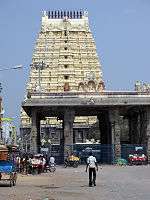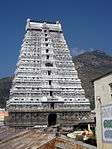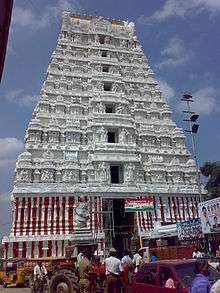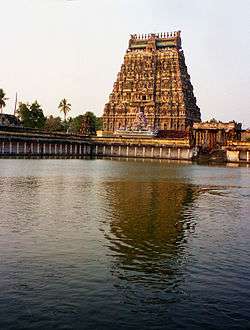Pancha Bhoota Stalam
Pancha Bhoota Sthalam refers to five temples dedicated to Shiva,[1] each representing a manifestation of the five prime elements of nature: earth, water, fire, air, and space.[2] Pancha indicates "five," Bhoota means "elements," and Sthala means "place." The temples are located in South India, four in Tamil Nadu and one in Andhra Pradesh. The five elements are believed to be enshrined in the five lingams[1] of the temples, with each lingam named based on the element represented.
| Part of a series on |
| Shaivism |
|---|
 |
|
Scriptures and texts
|
|
Philosophy
|
|
Practices |
|
Schools
Saiddhantika Non - Saiddhantika
|
|
Related
|
Pancha Bhootam
According to Hinduism, life and the various species originated by the combination of planetary globes and the five manifestations of nature namely earth, water, fire, air, and space. Bhoota (Sanskrit:भूत) in Sanskrit means compound and maha bhoota indicates a big compound.[3] According to Ayurveda, an ancient Indian medical system, the equilibrium of the body with the pancha bhoota is governed by the principles of tridoshas - kaph (phlegm), pitta (bile), vayu (gas), dhātu and malas (waste products).[4] Rabindranath Tagore, a Nobel laureate for literature, in his book, Pancha bhoota, has explained the emotional faculty of the human mind is keenly sensitive to all objects of light, colour, sound, effect of speed, sun, moon and stars.[5]
The Five Temples
In Thiruvannamalai temple, Shiva is said to have manifested himself in the form of a massive column of fire, whose crown and feet could not be found by the Hindu God of creation Brahma and Hindu God of preservation (or maintainer) Vishnu. A celebration of this manifestation is seen even today in the age old traditions observed during the festivals of Sivarathri and Karthigai Deepam. The Agni Lingam explains the mythics of life - duty, virtue, self-sacrifice and finally liberation by and through ascetic life at the end of Agni kalpa.[6]
In Thiruvanaikaval temple, Shiva represents water element where the appu lingam is submerged in water [1] and a perennial sub-terrain spring gushes around the lingam.[7]
In Chidambaram, space is worshiped as Shiva (akasha lingam) to signify God is beyond human comprehension. Unlike the other temples, this one does not contain a physical stone lingam.[8]
Imagemap:https://goo.gl/maps/BuCyXP7wCY32
| Category | Lingam | Temple | Location | Coordinates |
| Earth | Prithivi Lingam[8] | Ekambareswarar Temple[9] | Kanchipuram | 12°50′51″N 79°42′00″E |
| Water | Appu Lingam (Jambu Lingam)[1] | Jambukeshwarar Temple, Thiruvanaikaval | Thiruvanaikaval, near Trichy | 10°51′12″N 78°42′20″E |
| Fire | Agni Lingam (Jyothi Lingam)[6] | Arunachaleswara Temple | Thiruvannamalai | 12°13′53.76″N 79°4′1.92″E |
| Air | Vayu Lingam | Kalahasti temple[10] | Kalahasthi, Andhra Pradesh | 13°44′58″N 79°41′54″E |
| Space | Aagaya Lingam (Akasha Lingam)[11] | Thillai Natarajar Temple | Chidambaram | 11°23′58″N 79°41′36″E |
Gallery

 Arunachaleshwarar Temple, Thiruvannamalai, Tamil Nadu (Fire)
Arunachaleshwarar Temple, Thiruvannamalai, Tamil Nadu (Fire) Kalahasti Temple, Srikalahasti, Andhra Pradesh (Air)
Kalahasti Temple, Srikalahasti, Andhra Pradesh (Air) Natarajar Temple, Chidambaram, Tamil Nadu (Space)
Natarajar Temple, Chidambaram, Tamil Nadu (Space)
Notes
- Ramaswamy 2007, pp. 301-302
- A dictionary, Canarese and EnglishWilliam Reeve, Daniel Sanderson
- Daivajña 1996, p. 12
- J. 2008, p. 215
- Tymieniecka 2002, p. 40
- Blabatsky 1981, p. 176
- Tourist Guide to Tamil Nadu. P.76
- Tirtha: holy pilgrim centres of the Hindus : saptapuri & chaar dhaam, Subhadra Sen Gupta, p. 66
- https://shaivam.org/siddhanta/bootha.html
- Bajwa 2007, p. 271
- M.K.V 2007, p. 37
References
- Bajwa, Jagir Singh; Ravinder Kaur (2007), Tourism Management, New Delhi: S.B. Nangia, ISBN 81-313-0047-1.
- Knapp, Stephen (2005), The Heart of Hinduism: The Eastern Path to Freedom, Empowerment and Illumination, NE: iUniverse, ISBN 978-0-595-35075-9.
- Ramaswamy, Vijaya (2007), Historical dictionary of the Tamils, United States: Scarecrow Press, INC., ISBN 978-0-470-82958-5
- Tourist guide to Tamil Nadu (2007), Tourist guide to Tamil Nadu, Chennai: T. Krishna Press, ISBN 81-7478-177-3.
- The Theosophical Glossary (1918), The Theosophical Glossary, California: Theosophical Publishing House, ISBN 81-7478-177-3.
- M.K.V., Narayan (2007), Flipside of Hindu Symbolism: Sociological and Scientific Linkages in Hinduism, California: Fultus Corporation, ISBN 1-59682-117-5.
- Daivajña, Veṅkaṭeśa (1996), Sri Sarwarthachintamani: English translation, Volume 1, Delhi: Motilal Banarsidass Publishers Private Limited, ISBN 81-208-1352-9.
- J., Agarwal (2008), I Am Proud to be a Hindu, Delhi: Hindoology Books, ISBN 978-81-223-1022-1.
- Tymieniecka, Anna-Teresa (2002), Analecta Huseerliana The Year Book of Phenomenal Research, Volume LXXVI - Life, truth in its various perspectives: cognition, self-knowledge, Creativity, Scientific Research, Sharing-in-Life, Economics..., Netherlands: Kluwer Academic Publishers, ISBN 1-4020-0071-5.

